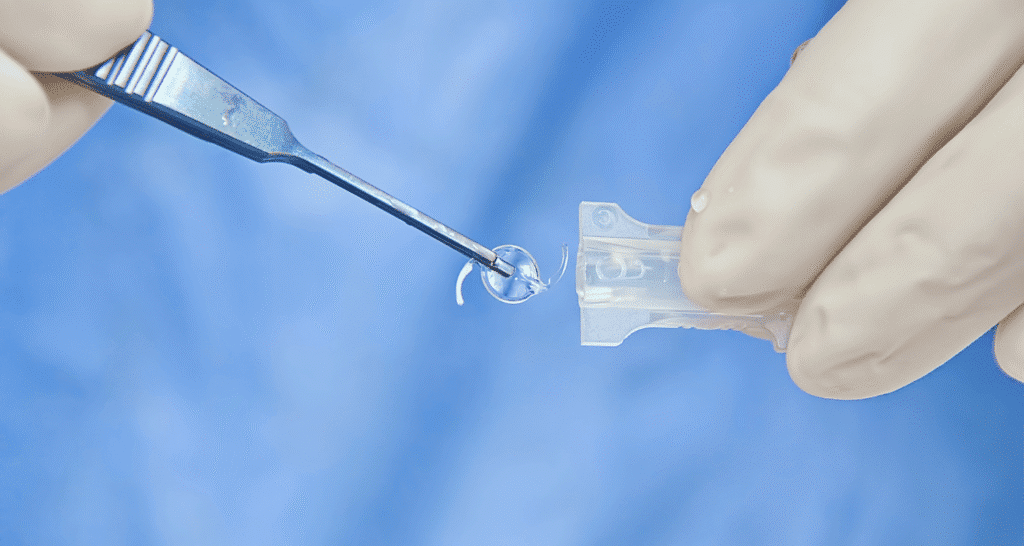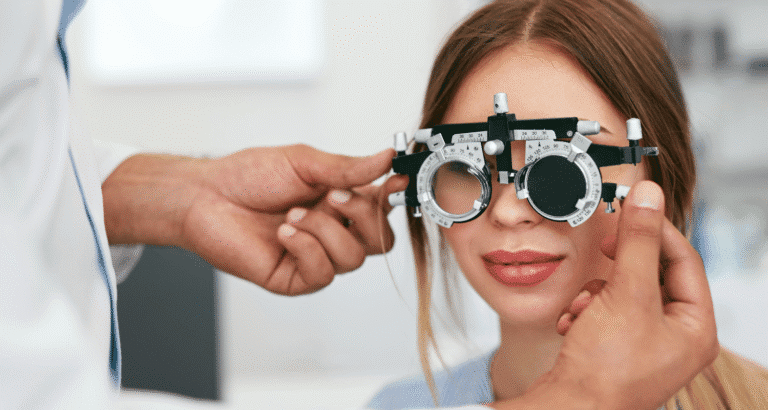Intraocular lenses, or IOLs, are artificial lenses placed in the eye during cataract surgery to replace the cloudy natural lens. These lenses come in several types, based on how they focus light and the extent of their visual range.
The most common options include monofocal, multifocal, extended depth of focus (EDOF), and toric IOLs. There are also advanced lenses like accommodating IOLs that move with the eye muscles and light-adjustable lenses (LALs) that can be fine‑tuned after surgery.
Monofocal lenses give clear vision at one set distance. Multifocal lenses provide near, intermediate, and far vision through a series of rings on the lens. EDOF lenses create a smooth range of vision from distance to intermediate.
Toric lenses correct astigmatism by using different focusing powers across the lens. Accommodating lenses shift inside the eye to support a wider focus range. LALs allow surgeons to adjust the lens power with light after the eye heals.
These IOL differences matter because each one affects how you see after surgery. Your choice depends on your daily needs, eye health, and how much you want to rely on glasses.
Main Types of Intraocular Lenses
Monofocal IOL
This is the standard IOL. It gives clear vision at one distance, usually far away. If set for distance, you’ll likely still need reading glasses for near tasks. It is best for patients who don’t need correction for astigmatism and whose main goal is good distance vision. One drawback is dependence on glasses for reading.
Multifocal IOL
Multifocal lenses are designed with multiple zones so you can see clearly at near, intermediate and far distances. They appeal to active people who want less reliance on glasses. A trade‑off: you might see halos or glare around lights, especially at night. Patients must be aware of this.
Toric IOL
If you have astigmatism, a misshaped cornea that causes blurred or distorted vision, a toric IOL corrects that in addition to replacing the cloudy lens. Alignment of the lens during surgery is crucial. If misaligned, you won’t get full benefit of the astigmatism correction.
Extended Depth of Focus (EDOF) IOL
EDOF lenses provide a smooth range of vision from distance to intermediate without fixed focus points. They give fewer visual disturbances than some multifocal lenses but may still require glasses for fine print or very near work.
Accommodating IOL
These lenses attempt to mimic the eye’s natural lens by moving or changing shape when your eye muscles contract and relax. They offer a more “natural” vision feel. Still, their performance varies from person to person and with age or eye health.
Light Adjustable Lens (LAL)
A more advanced option: the lens material is photosensitive. After surgery you come back and light is used to fine‑tune the lens power. This gives more customization in the post‑operative period.
Small Aperture IOL
This is a newer type that works by reducing the amount of light entering the eye in a controlled way to increase depth of field and reduce visual disturbances. It can be an option if your cornea is irregular or you have specific issues that other lenses don’t address.
Advanced & Specialized Lenses
Beyond the main types, you’ll find lenses like the Trifocal IOL (three focus zones: near/intermediate/far), Enhanced Monofocal Lenses (monofocal lens with improved intermediate vision) and lenses made of various materials: PMMA, silicone, hydrophobic acrylic, etc. EyeWiki The choice of material affects how the lens behaves in your eye, including clarity, flexibility and how it handles behind‑the‑lens haze.

Factors to Consider When Choosing an IOL
When you and your eye doctor select a lens, consider the following:
- Vision goals: Do you want excellent distance vision, reading vision, or both? Do you use a computer often?
- Astigmatism: If you have astigmatism, a toric IOL may be best.
- Budget & insurance: Standard monofocal lenses are usually covered by insurance. Premium lenses (multifocal, toric, LAL) often cost more.
- Lifestyle: If you drive at night, use a computer, or read frequently, consider selecting a lens that meets your specific needs.
- Eye health: Conditions like glaucoma, macular degeneration, or corneal issues can affect how an IOL works for you.
- Tolerance for trade‑offs: Are you okay with occasional halos/glare in exchange for less reliance on glasses?
Comparisons: Which IOL is Right for You?
Here are some common comparisons you should know:
EDOF vs Multifocal
EDOF gives smoother vision across distances with fewer light‑related side effects. Multifocal gives more range (including near) but may have more halos/glare.
Monofocal vs Multifocal
Monofocal is simpler and lower cost, but you’ll likely still wear reading glasses. Multifocal may reduce glasses but has trade‑offs.
Toric vs Standard Monofocal
If you have astigmatism, toric gives the extra correction. Standard monofocal does not.
LAL vs Multifocal
Light adjustable lens gives post‑surgery fine tuning; multifocal gives multi‑distance focus upfront but less adjustability.
FAQs About Intraocular Lenses
What are the different types of intraocular lenses?
Monofocal, Multifocal, Toric, EDOF, Accommodative and Light Adjustable are the main ones.
Which IOL is best for near vision?
Multifocal or Trifocal lenses are generally preferred for strong near vision.
What is the difference between monofocal and multifocal IOL?
Monofocal treats one distance only (near or far). Multifocal supports multiple distances (near, intermediate, far).
Can IOLs correct astigmatism?
Yes. Toric IOLs are designed to correct astigmatism.
Are premium IOLs worth the cost?
It depends on your lifestyle, vision goals and budget. If you want less dependence on glasses and your eye health allows it, they may be worth it.
Is there a lens that can be adjusted after surgery?
Yes. The Light Adjustable Lens (LAL) allows post‑operative tuning.
What’s the latest IOL technology?
EDOF and Light Adjustable lenses are among the more recent innovations.
What material are IOLs made from?
Common materials include acrylic (hydrophobic or hydrophilic), silicone and PMMA. Each has pros and cons.
What is the most popular IOL for cataract surgery?
The monofocal IOL is still the most widely used option because it is reliable and usually covered by insurance.
What is the downside of multifocal IOL?
Possible downsides include halos, glare, reduced contrast sensitivity and cost.
What is the best cataract lens for night driving?
If you are concerned about night vision, a monofocal IOL set for distance vision is often recommended.
How many times can a cataract lens be replaced?
In most cases, IOLs are intended to be permanent. Replacement is rare and only done when complications arise.





